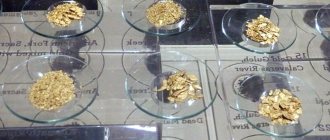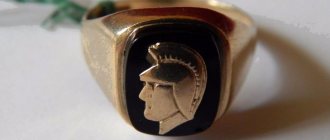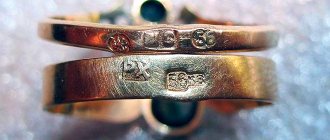The hallmark of gold and silver is a special mark that helps determine the amount of precious metal in the alloy. It is noteworthy that initially in Rus' only silver was hallmarked, but at the beginning of the 18th century gold was also hallmarked. There are several hallmark systems; previously, a special mark was placed on silver or gold. It contained information not only about the amount of precious metal in the ligature, but also about the craftsman who made the jewelry.
Ring test
Carat system
In Europe and the USA, a different system for indicating gold content is used - carat. Carats indicate the number of parts of pure gold from 24 parts of the alloy.
- 9 carat hallmark is 9 parts of gold out of 24 (375 hallmark)
- 10 carat hallmark is 10 parts of gold out of 24 (500 hallmark)
- 14 carat hallmark is 14 parts of gold out of 24 (585 hallmark)
- 18 carat hallmark is 18 parts of gold out of 24 (750 hallmark)
- 24 carat hallmark is 24 parts of gold out of 24 (pure gold).
The karat system is used today throughout the world. If you buy jewelry outside the CIS, the standard will almost always be indicated in the karat system.
Before the carat system in Western Europe, there was a lot standard (12 lots = 750 standard).
From the history of testing in Russia
The first Moscow hallmark on precious metal discovered in Russia dates back to 1651. The mark was an image of a double-headed eagle and a date indicated in Slavic letters. These were not yet complete samples in the modern sense, since they did not reflect the content of precious metal in the alloy. But such a mark was evidence that the metal corresponded to a model recognized by law.
In those days, the “Lyubsk thalers” or “efimkas” were considered the standard - these were imported European coins that were melted down into jewelry. At the end of the 17th century, “levok” appeared in Russia - a mark that indicated a low-grade gold sample.
State hallmarking in Russia was officially legalized in 1613 for silver, and in 1700 for gold. No mark was placed on other metals.
In all cities of Russia in the 18th-19th centuries they put a stamp with the image:
- coat of arms of the city, the year in a shield of various shapes;
- the initial letters of the jeweler's first and last name (the assayer's name);
- marks of the craftsman who made the product;
- two numbers indicating the sample (the number of spools in a ligature pound).
All craftsmen and jewelers in factories were required to put their name stamps and present the products to the state assayer.
Nowadays, the “manufacturer’s name” is the second mark that is required on a piece of jewelry. It is a kind of analogue of a label on clothing and contains information about the manufacturer. By deciphering the print, you can get the most complete information about the purchased jewelry. The “name” stamp is a four-digit alphabetic code enclosed in a single outline. It is rectangular in shape and, as a rule, is applied next to the “test”. The print contains four letters:
- The first will indicate the year when the product was produced (for example, “N” - 2012, “O” - 2013, “P” - 2014).
- The second will indicate the code of the Russian state assay inspection body where the product was tested (for example, “B” - Verkhne-Volzhskaya).
- The last two letters are the manufacturer’s individual code, which cannot be repeated within the same inspection.
Using the manufacturer's stamp, in case of doubt about the jewelry, you can find out when, where and by whom the jewelry you purchased was produced.
On January 1, 1899, a uniform stamp was introduced in Russia. The image represented a woman's head in a kokoshnik, with the initials of the manager of the assay district. Sometimes numbers were set - spool test (72 spools = 750 test). This type of marking, in different versions, existed until 1927, after which the system of testing and marking was changed. Instead of a woman’s head, the head of a worker with a hammer appeared in the kokoshnik, and the sample itself began to be designated by the number of thousandths of gold in the alloy, as is currently done. Platinum and palladium samples were added to the system. The hallmark contains the code of the assay office (a letter of the Greek alphabet).
Since 1958, Soviet hallmarks began to depict a hammer and sickle against the background of a five-pointed star. And the hallmark inspection code began to be denoted in Russian letters.
Since 1994, hallmarks have been introduced in Russia, which are currently in effect. Stamps with a hammer and sickle were in use until 2000.
Today, the stamp depicts a woman’s head in a kokoshnik in profile, directed to the right. Also depicted is a Russian letter - the code of the assay office. Each of the 18 assay inspections has its own letter.
Rules for hallmarking jewelry
State control has been established over samples of gold and silver. All products must undergo trial control and branding. Orders, medals and coins are not subject to stamping. However, their samples are regulated and controlled. Products made of precious metals without a hallmark cannot be bought or sold. counterfeiting of hallmarks is prohibited by law.
Test marks on products can have different shapes and designs. The drawing can be combined with the image of numbers corresponding to samples or with conventional numbers, each of which corresponds to a specific sample.
Which sample should I choose?
Looking at the treasures in the windows of jewelry stores, millions of buyers ask themselves the question - which sample to choose? Which is better?
If you do not have color preferences, then you need to choose a product according to three main criteria:
- practicality
- aesthetic appeal
- price
The most common gold standard is 583rd . The color of such a metal can vary - this directly depends on the percentage of various metals in the alloy. For example, if an alloy of 583-carat gold consists of 58.3% gold, 36% silver, 5.7% copper, then in this case the metal has a greenish tint. The same 583rd sample with a content of 18.3% silver, 23.4% copper, already has a pink tint. If this alloy contains 8.3% silver and 33.4% copper, then the gold will have distinct shades of red.
In general, 583- carat gold is considered the most practical, and therefore enjoys increased popularity. The 50% percentage of gold in the alloy makes the products durable - such jewelry is less scratched and does not deform.
The same cannot be said about 958-carat . This alloy is not durable, so it is not in high demand among jewelry buyers. This alloy also contains small amounts of silver and copper. The metal turns out to be bright yellow – almost pure gold. Often used in making wedding rings. But due to the increased softness, the surface of such jewelry requires regular polishing.
The alloy of 750 standard consists of 3 components - gold, copper, silver. Sometimes some rhodium, palladium, nickel and zinc are included as alloys. The color of the metal can be very diverse - from yellow-green to reddish and white. The alloy is very technical and ideal as a base for jewelry enamel. Almost always, jewelry made of 750-carat gold is distinguished by its noble shades and original, sophisticated design, since it is not produced in very large quantities.
The 375-carat gold alloy consists of the following components: 37.5% gold, 10.0% silver, 48.7% copper, 3.8% palladium. Widely used in the production of wedding rings.
Mark on precious metals
Sample is a guarantee of quality and at the same time an indicator of the quantity of exactly how much precious metal is contained in the alloy. As a rule, jewelry and other products are not made from pure metal; impurities are added to it - other substances that change the characteristics of silver or gold.
If we talk about pure Au, then this element, despite all its positive qualities, is distinguished by its high weight, softness and tendency to scratches. For this reason, jewelry is made from ligature, diluting gold with other metals; The alloy may contain the following elements: silver, copper, nickel, platinum, etc.
The alloy takes on the characteristics not only of Au, but also of other elements. As a result, the alloy has the following properties: durable, easy to forge and melt, and oxidizes upon contact with water and air. The less gold contained in the alloy, the faster it oxidizes when in contact with water and air.
The mark indicates not only the quality of the product, but also its value. Today in the store you can find jewelry with the following markings:
- 375;
- 585;
- 750;
- 958.
In products 375, the marking indicates that the alloy contains no more than 38% Au. Such products are not highly durable, they quickly darken upon contact with water and air, and do not tolerate interaction with reagents. Jewelry with a similar mark can have a classic yellow color, as well as a red tint if the alloy contains copper.
585 is the most popular gold standard in Russia. It is noteworthy that it appeared in the USSR. But previously there was a 583 marking, which was changed to 585 when it was considered that jewelry with the same mark would be poorly valued abroad.
The alloy marked 585 contains about 59% Au; such jewelry is characterized by good resistance to environmental factors and good strength. Jewelry can have a pleasant yellow or even white tint if platinum is present in the ligature.
750 marking indicates that the ligature contains from 72 to 78% gold. This test is only used on premium jewelry; they are not accessible and can have a green, yellow, white, or even red tint. The products are resistant to environmental factors, reagents and high temperatures. They oxidize slowly and retain color and shine for a long time.
958 standard is rarely used for making jewelry. The fact is that the cost of products with such markings is very high. Jewelry is produced to order; they differ not only in price, but also in their rather heavy weight. The properties of gold do not allow the creation of openwork weaves from the alloy; for this reason, jewelry with such a mark is not distinguished by its elegance. The alloy contains at least 96% Au.
There is also a 999 standard, which is used for pure gold, which contains practically no impurities. You won’t be able to find alloy products with such markings in a boutique or store. In the old days, wedding rings were made from pure gold. In most cases, the metal marked 999 is made into ingots.
What types of precious metals are there?
Pure silver is also rarely used in the jewelry industry; the following samples are considered the most popular:
- 875;
- 916;
- 925;
- 999.
The 875 mark is placed on those products that are not of high quality. The ligature contains no more than 88% silver. Products with such a hallmark are used in medicine, and the mark is also placed on cutlery and jewelry that are not very expensive.
Jewelry made from 916 silver has good characteristics, but in order to increase the wear resistance of the products, they are often coated with enamel. The latter can also be gilding. High-end cutlery is also made from silver with this marking.
925 silver is an alloy of it and copper. The alloy contains about 7.5% copper, and the rest is silver. The ligature has good characteristics and is ideal for the production of jewelry. Metal cutlery with such a mark is rarely made.
Silver marked with three nines is considered pure and contains no impurities. This metal is practically not used in the jewelry industry; ingots are made from it.
Platinum is highly durable and is used not only for making expensive and luxurious jewelry.
The following markings are placed on platinum:
- 585;
- 850;
- 900;
- 950.
Platinum marked 585 is white gold. The composition of the alloy, in addition to two noble metals, includes impurities. Ligature is used in the jewelry industry.
Jewelry marked 850 contains various impurities; platinum is diluted with tungsten, copper and iridium. In percentage terms, the amount of platinum does not exceed 85.
Jewelry that is marked 900 is not distinguished by its bright shine and chic appearance. Among platinum lovers, products of this standard are considered budget. Finding them in the store will not be difficult.
As for 950, it is loved by jewelers because it is ideal for creating luxury jewelry. Such jewelry is encrusted with diamonds or other stones; they are not affordable.
Bankers are only interested in platinum marked 999; bars are made from this metal. Money is invested in them.
White gold
White gold, in fact, does not exist. This is ordinary gold with different metal contents in the alloy.
- 585-carat white gold: 23.7-28.7% - silver, 13.0-18% - palladium, 17% - nickel, 8.7% - zinc, 16% - copper.
- 18k white gold: 7.0-15.0% silver, 14% palladium, 4% nickel, 2.4% zinc, 7.5-16.5% nickel, 15% copper .
White gold is in high demand among jewelry lovers and is an excellent companion for diamonds.
What is a ligature
Gold has been admired since time immemorial; it was called both fragments of the sun and a gift of the gods. However, in its original form this metal looks completely unimpressive. Pure Aurum has nothing in common with the noble metal; it has a bunch of disadvantages:
- susceptible to corrosion;
- easily susceptible to any mechanical damage;
- has a dull and inexpressive color.
Products made from such material could hardly be considered a model of perfection. And they certainly would not have been able to fit into the family category; their life would have been too short.
Without “strengthening” impurities, gold is not suitable for the work of jewelers.
They were able to correct the situation by mixing gold with slightly less noble silver or even cheaper copper. Often the “recipe” for high-quality gold involves the addition of palladium and zinc.
By combining them in different proportions, people have learned not only to create ideal alloys for making gold products, but also to give them different shades. Today, not only metal of the classic yellow color is popular. Ladies are happy to wear white, dark, pinkish and even emerald shades.
Alloys that “strengthen” gold and give it complete beauty are called alloys. Its final price depends on the ratio of the noble metal and impurities. The most expensive is the one that is almost pure Au. Financiers respect him. But jewelers don’t like it at all. They have their own idea of what standard of gold guarantees the best result.
Silver
In Russia, the following silver standards are legally permitted for use: 800, 830, 875, 925, 960, 999.
875 standard silver is the most practical and widespread. It is from this alloy that most silver jewelry is made. The alloy contains 81.5% pure silver. The rest is made up of copper, which effectively prevents the oxidation of the metal. 875 sterling silver is less susceptible to tarnishing than 830 and 720 sterling silver.
Tableware items are made from 916 sterling silver. The 960-grade alloy is used in the manufacture of particularly filigree products.
To protect silver and brass items from oxidation, their surface is often coated with a thin layer of .999 gold (gilding) or .999 silver (silver plating).
Platinum and palladium
In jewelry, platinum and palladium alloys are used in very small quantities.
Platinum alloy is being successfully replaced today by white gold. Some jewelry is made from a two-component 950-carat alloy, which contains copper and iridium along with platinum.
Palladium has not yet been recognized as an independent metal for the production of jewelry. However, palladium has a very good future because it is cheaper than platinum, has a rich white color, excellent machinability and a long-lasting luster.
Historical facts
- In Russia, a single stamp in the form of a woman’s profile in a kokoshnik, reflecting the gold content, was introduced in 1899.
- In Soviet times, a sample in the form of a worker’s head appeared, and in 1958, the stamps began to include an image of the symbol of the unity of the proletariat and the peasantry - a hammer and sickle against the background of a star.
- The female head in a kokoshnik returned to the hallmarks in 1994.
- In the Russian Empire, a spool system was used for establishing samples: the weight of gold was expressed in 96 units of the alloy. The most common options were 94, 92, 82, 72, 56 samples. In the 1920s The Soviet Union switched to the metric system, which is still used today.










